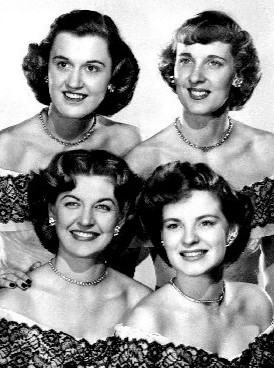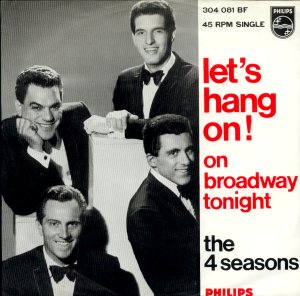
The Chordettes were an American female vocal quartet, specializing in traditional pop music. They are best known for their 1950s hit singles "Mr. Sandman" and "Lollipop", both of which sold over a million copies.

"Mr. Sandman" is a popular song written by Pat Ballard and published in 1954. It was first recorded in May of that year by Vaughn Monroe & his orchestra and later that year by The Chordettes and the Four Aces. The song's lyrics convey a request to "Mr. Sandman" to "bring me a dream" – the traditional association of the folkloric figure. The pronoun used to refer to the desired dream is often changed depending on the sex of the singer or group performing the song, as the original sheet music publication, which includes male and female versions of the lyrics, intended.
"Goodnite, Sweetheart, Goodnite" is a popular song that was a hit during the mid-1950s. It was written by Calvin Carter and James "Pookie" Hudson in 1951, and was first recorded by The Spaniels in 1953. It has also been released by some artists as "Goodnight, Well It's Time to Go".
"Hearts of Stone" is an American R&B song. It was written by Eddie Ray and Rudy Jackson, members of the San Bernardino, California-based rhythm and blues vocal group the Jewels which first recorded it for the R&B label in 1954. The Jewels began as a gospel group, then became the Marbles, recording for the Lucky label out of Los Angeles. According to Johnny Torrence, leader of the Marbles/Jewels, it was taken from a song they recorded in their gospel days.
"Born to Be with You" is a song by the American female vocal quartet The Chordettes. Written by Don Robertson, the song was released in 1956. The song reached a position of number five on the pop charts in the United States. In Ireland, Butch Moore & The Capitol Showband took it to No. 1 in 1965.
Linked here are Billboard magazine's number-one rhythm and blues hits. The Billboard R&B chart is today known as the Hot R&B/Hip-Hop Songs chart.

"Chain Gang" is a song by American singer-songwriter Sam Cooke, released as a single on July 26, 1960.

"Surrender" is a single by Cheap Trick released in June 1978 from the album Heaven Tonight. It was the first Cheap Trick single to enter the Billboard Hot 100 chart, peaking at number 62. Its success in Japan, as well as the success of its preceding singles "Clock Strikes Ten" and "I Want You to Want Me", paved the way for Cheap Trick's concerts at Nippon Budokan in Tokyo in April 1978 which were recorded for Cheap Trick at Budokan, the group's most popular album.

"Let's Hang On!" is a song composed by Bob Crewe, Sandy Linzer, and Denny Randell that was popularized by the Four Seasons in 1965.

"You're the Best Thing That Ever Happened To Me" — also known simply as "Best Thing That Ever Happened To Me" — is a song written by Jim Weatherly, and produced by Don Law. It was first recorded in 1973 by Danny Thomas. Soon after it was done by Ray Price from his album You're the Best Thing That Ever Happened To Me. The song enjoyed two runs of popularity, each by an artist in a different genre.
The Teen Queens were an American musical group from the 1950s, most remembered for their hit single "Eddie My Love", which reached No. 14 on the Billboard Hot 100 chart and No. 3 on the R&B Best Sellers charts in March 1956.

"Ride My See-Saw" is a 1968 single by the English progressive rock band the Moody Blues. It was written by the band's bassist John Lodge, and was first released on the Moody Blues' 1968 album In Search of the Lost Chord. It was the second of two singles from that album, the other being "Voices in the Sky".
"Busted" is a song written by Harlan Howard in 1962. It was recorded by Johnny Cash for Cash's 1963 album Blood, Sweat and Tears. It has been recorded by several notable artists, including Ray Charles, Nazareth (1977), John Conlee (1982) and Chris Ledoux (1982).
"Chains Of Love", a 12-bar blues, was written by Doc Pomus.
"Pretty Little Angel Eyes" is a 1961 song by American singer Curtis Lee. It was released on Dunes Records, #45-2007. Phil Spector served as producer, and also produced Lee's follow-up hit "Under the Moon of Love".






